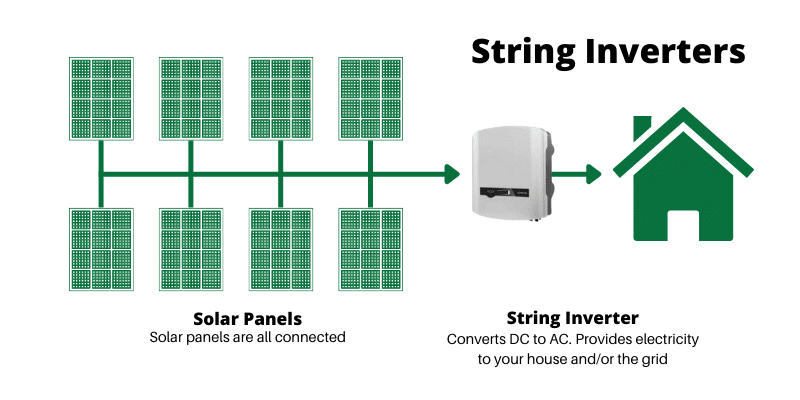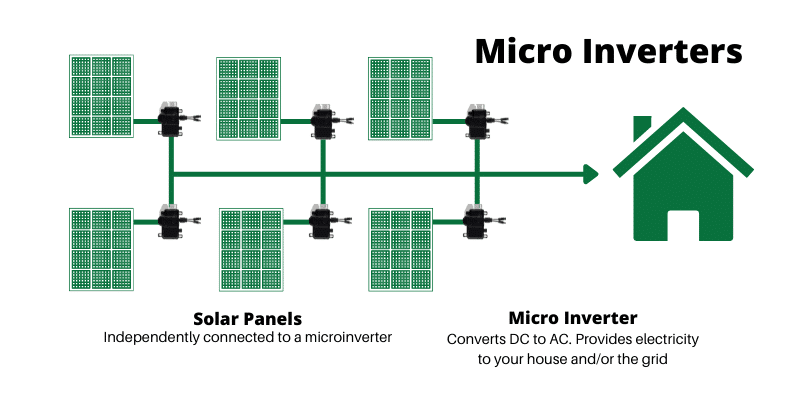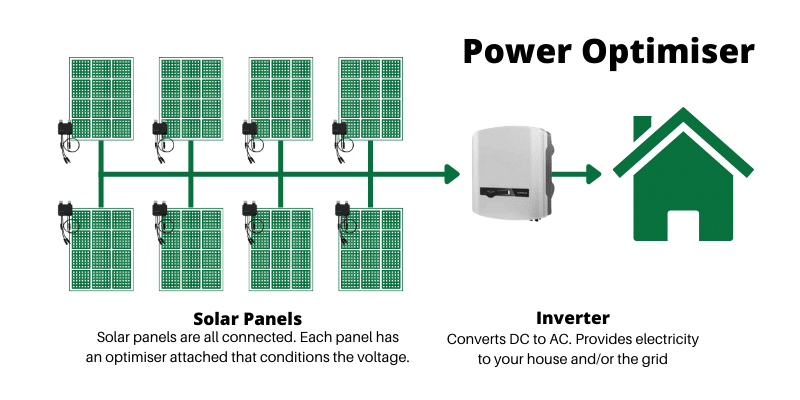On This Page
Solar energy doesn’t provide electricity in a format that can actually turn on your lights. This is where inverters step in. Think of them as a currency exchange for your power. They take the direct current (DC) electricity generated by your solar panels and turn it into an alternating current (AC). This is the kind of electricity that actually flows through your home’s wiring and can power everything from your fridge to your TV.
Solar energy systems are only as reliable as their weakest link and inverters are a very important part of the system. There are three primary inverter setups: string inverters, inverters with power optimisers (also known as DC optimisers) and microinverters. In this article we will explain the pros and cons of each to help you decide what is right for you.
String Inverters

String inverters are your “out of the box” option when it comes to solar panel invertors and are the most commonly used. String inverters have one centralised inverter connecting a series or “string” of solar panels.
Advantages
- Lowest cost option
- Broad variety of products available
- The technology is the industry standard and is therefore well understood
Disadvantages
- As they are connected to multiple solar panels, the performance is equal to the worst performing panel; i.e. if one panel is damaged, soiled or shaded, overall output can be dramatically reduced
- No ability to monitor each panel individually
- Not optimal if your solar panels are facing different directions
- Scaling to a larger system is more complicated and may require a second central inverter installation
Verdict
String inverters are a perfectly acceptable, cost-effective option if you don’t have any encroaching shade from nearby trees or a large chimney. They are also great if you have all of your solar panels facing the same direction. However, if you don’t fit these scenarios, then individual panel optimisation via a micro inverter or power optimiser will be your best option.
Lorem ipsum dolor sit amet, consectetur adipiscing elit. Ut elit tellus, luctus nec ullamcorper mattis, pulvinar dapibus leo.

Quick Fact: Module-Level Power Electronics
Module-Level Power Electronics or MLPEs are solar inverters that are installed on or near each solar panel, as opposed to a centralised string inverter that is installed away from the panels.
There are two main types of MLPEs – microinverters and solar panel optimisers. As the name suggests, MPLEs work on a per-panel basis to maximise solar panel output by individually optimising each one.
Microinverters

Microinverters, (also known as Module-Level Power Electronics or MLPEs) work on the same principle as string inverters, but instead of having one large central inverter, they have a small unit to convert power underneath or built into each individual solar panel. This gives each panel the ability to function independent from its neighbours.
Advantages
- Typically better performing than string inverters as the overall system efficiency is increased by maximising each panel’s output
- Each solar panels performance is independent of its neighbours, so an individual damaged, soiled or shaded panel will not affect your entire array
- Can monitor the production of every panel individually, meaning you can assess the number of kilowatt-hours (kWh) one solar panel in your array produces versus another
- Good for rooftops where solar panels may face different directions. They are particularly useful with solar panels that are facing south or west
- If your power demands increase, adding more solar panels and inverters is easier and less expensive than adding an additional central inverter for a string inverter system
- An all-AC system means no high-voltage DC power on your roof. AC power does not have nearly the same potential for arcing as DC power (though solar DC cable installed to today’s standards are as safe as any other electrical wiring in your home)
Disadvantages
- The main disadvantage is an additional cost to install individual inverters. This can make the upfront cost up to 20% more expensive than a string system
Verdict
While microinverters are more expensive than string inverters, their ability to make the most out of each panel allows you to get more power from your system overall. String inverters are still a great option for those on a budget, but if you’re after something that offers greater efficiency, flexibility and long-term ROI then microinverters are a compelling option.

Quick Fact: Inverter Warranties
The Australian industry-standard warranty for most string inverter technologies is typically 10-12 years, while MPLEs such as microinverters and power optimisers often have 25-year warranties. These periods can vary from brand to brand, so always check with your solar installer or the product’s manufacturer.
Power Optimisers

A power optimiser (DC optimiser) is not actually an inverter at all; they come as a small box that plugs into your solar panel ’s DC cables and your solar panel’s AC output.
While microinverters completely replace the need for a string inverter, power optimisers (also an MPLE) work in conjunction with the string inverter to increase power output. Instead of converting DC power to AC power at the panel site like a micro-inverter, power optimisers condition DC power and send it to a string inverter.
Power optimisers can be inbuilt in the panels themselves, or sold and fitted on separately.
Advantages
- This approach results in higher system efficiency than a string inverter alone by improving performance for solar panels on complicated roofs, or roofs that experience marginal shading during the day
- Upfront cost slightly more expensive than string inverters, but less than microinverters
- Like microinverters, optimisers can monitor the performance of individual solar panels
- From a safety perspective, optimisers reduce DC voltage in the PV string cables to touch-safe levels when the inverter is disconnected
Disadvantages
- High voltage DC is not eliminated on the roof when compared to microinverters
- Less flexible compared to microinverters as DC optimisers need to be designed to match the maximum panels per string on string inverters
- Less robust when compared to microinverters as if any individual optimiser fails then the entire string will fail
Verdict
Solar panel optimisers effectively deliver many of the same advantages as microinverters at a slightly lower cost. Both microinverters and power optimisers provide a higher system efficiency than string invertors, but for those who are after an even cheaper upfront installation cost with no sacrifice on performance then power optimisers can be an ideal option.

Quick Fact: Battery Compatibility and Integration
Batteries charge and discharge DC electricity. As power optimisers maintain the DC wiring to the central inverter, they are generally cheaper and easier to integrate.
Because microinverters operate on AC electricity, battery integration will always necessitate the addition of another battery inverter to AC couple it into the system. If you are buying a solar and battery package, this will add to the cost of integrating them with microinverters. However, if you’re planning on retrofitting a battery, you’re going to need to buy a battery inverter regardless and the integration cost will be the same whether you’re using microinverters or power optimisers.
So which option should I choose?

Quick Fact: AC-Modules An 'All-In-One' Solution
Sometimes referred to as “plug and play” modules, AC modules are solar panels with a pre-fitted microinverter. This approach is typically slightly more expensive than installing either microinverters or power optimisers separately, but it can offer a simpler and safer installation, improved electricity harvest and the elimination or reduction of other componentry. Your installation will certainly look neater, with fewer cables running around your roof.
Top Recommended Solar Inverter Brands
String Inverters: FIMER, Fronius, Huawei, Sunways
We are spoilt for choice when it comes to the wide array of quality solar string inverters on the market featuring advanced technology with clever online monitoring and smart home energy management features
FIMER, Fronius, Huawei and Sunways inverters are all considered top-tier when it comes to string inverters, each offering reliable performance and accurate monitoring.
Open Homes Australia Inverter Features:
Microinverters: Enphase
Leading the Australian market in microinverter technology is Enphase. In addition to the maximised system performance you get from individual panel optimisation, Enphase microinverters also allow homeowners to monitor their solar system via the MyEnlighten web application. The easy-to-use app allows homeowners to check their system’s status at-a-glance, tracking each panel’s health and performance on-the-go. It also gives users insights into their energy usage, allowing total control over their energy bills.
Wilf Johnston, General Manager-APAC of Enphase Energy explains that Enphase microinverter technology is smarter, safer and tougher than the competition.
“At the end of the day, we’ve got the cloud-based smarts, data analytics and the ability to connect to any microinverter anywhere around the world.
“The safety – because we have the ability to turn stuff off instantly if there’s an issue…that rapid shutdown capability. Also, Enphase being an AC energy system, once you switch it off at the wall everything’s dead, as opposed to a DC system where everything is still going to be live.
“And tougher – it’s IP65 [rating], so it can survive more heat than the competition and it’s waterproof.”
Wilf explained that it’s up to the customer to decide whether or not it’s worth the investment. However, when something goes wrong, having a microinverter and the Enphase support network can make all the difference for both installers and homeowners.
“We can troubleshoot what the issue is…and because it’s a distributed system, if one of them breaks [out of 20 for example], well you’re only down 5%, whereas a single string, bang, you lose 100% of your energy.”
See the Enphase microinverter technology in action in this recent segment of Open Homes Australia
Power Optimiser: SolarEdge
Founded in 2006, SolarEdge established the DC power optimiser segment and leads it with over 70% market share.
SolarEdge Power Optimisers ensure each solar module is constantly kept at maximum power point (MPP), preventing losses attributable to issues including mismatched panels or partial shading conditions; therefore accelerating system investment payback time
While solar power systems are generally safe, the Solar Edge Power Optimiser enhances this safety, featuring very rapid automatic DC shutdown once the inverter is turned off, after grid disconnection or in reaction to high temperature.
Included with the SolarEdge system is access to an online portal, allowing system owners to monitor their array anytime, anywhere. In addition to performance data; module level, real-time alerts of system issues are pinpointed on a virtual map available via the portal.
The Solar Edge Power Optimiser can be retrofitted to existing PV systems to solve mismatch challenges and given the features, also finally frees owners of challenging rooftops to be able to make more use of their rooftop real estate.
AC Modules: SunPower
SunPower’s AC module systems combine industry-leading solar panel technology with advanced microinverters from Enphase to maximise your roof’s potential.
The result? Greater reliability over your system’s lifetime, with superior output in real-world conditions—not to mention the enhanced curb appeal that comes with a simpler, cleaner system design.
And it’s all backed by the peace of mind that comes with 40 years of category-leading warranty protection and the professional expertise gained from 35+ years in solar.
See SunPower’s AC modules in action in this recent segment of Open Homes Australia
Our professional solar installers in Melbourne will assess and determine your energy needs. We customise a solar panel system in Melbourne to fit the roof size of your property, ensuring you receive the most suitable solar panel system for your Melbourne home, meeting to property’s energy requirements.









































